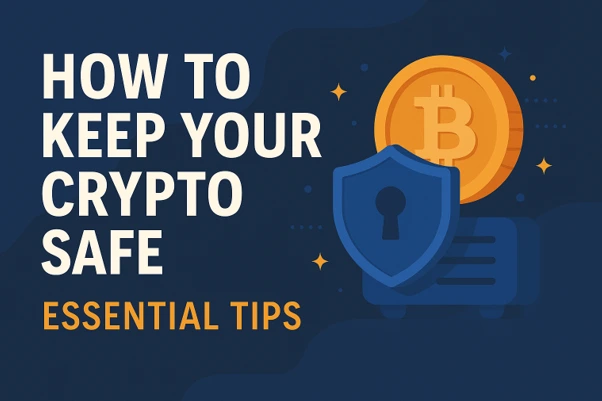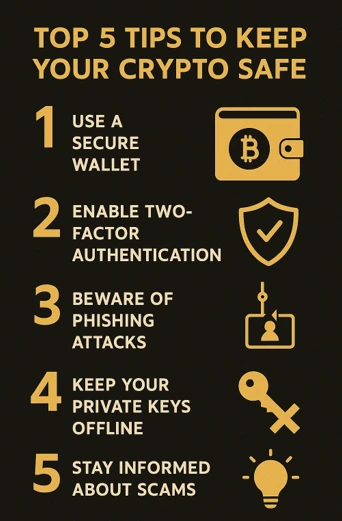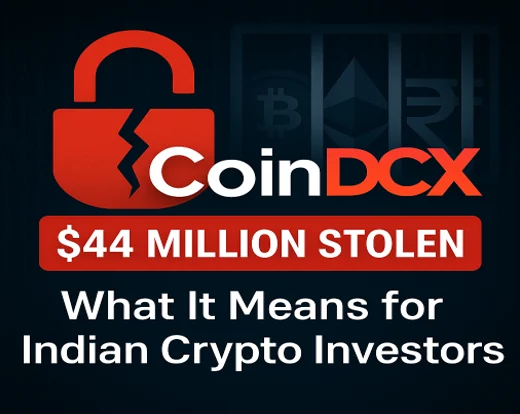
How to Keep Your Crypto Safe
Cryptocurrency has revolutionized the financial landscape, offering decentralized and borderless transactions. But with great opportunity comes great risk. Hackers, scammers, and cybercriminals are constantly finding new ways to steal digital assets. Unlike traditional banks, where you can recover lost funds, in the crypto world, security is entirely your responsibility. How to keep your crypto safe is a crucial question every investor should ask. This guide will equip you with essential security measures, recent hacking incidents, and best practices to safeguard your digital wealth.
Understanding Crypto Security
Unlike traditional banking systems, cryptocurrencies operate on decentralized networks, meaning you are solely responsible for their security. There’s no central authority to recover lost or stolen funds, making it essential to take preventive measures.
Why Crypto Security Matters
- Irreversible Transactions – Once a crypto transaction is made, it cannot be undone.
- Cyber Threats – Hackers target wallets, exchanges, and individuals to steal digital assets.
- Scams & Fraud – Phishing, Ponzi schemes, and fake investment opportunities are rampant.
- Personal Responsibility – Unlike banks, crypto holders must manage their own security.
Recent Crypto Hacks and Security Breaches
To understand the urgency of crypto security, let’s look at some recent major hacks:
1. Bybit Exchange Hack (February 2025)
In February 2025, Dubai-based cryptocurrency exchange Bybit suffered a devastating hack, losing approximately 400,000 Ethereum tokens valued at $1.5 billion. This was one of the largest exchange hacks to date. The attackers exploited vulnerabilities in Bybit’s multi-signature wallet system, facilitated by a security flaw in Safe{Wallet}, a third-party provider. Blockchain analysts suspect the Lazarus Group, a North Korean state-sponsored hacking collective, was behind the attack.
2. WazirX Exchange Breach (July 2024)
India-based cryptocurrency exchange WazirX was hacked in July 2024, resulting in the theft of $234.9 million. Hackers managed to manipulate smart contracts and exploit the exchange’s multi-signature wallet system. Once again, reports pointed to the Lazarus Group as the perpetrators. This breach forced WazirX to temporarily halt trading operations, underscoring the security risks faced by centralized exchanges.
3. North Korean Hackers and Global Crypto Thefts (2024)
Throughout 2024, North Korean hackers, including the Lazarus Group, were linked to multiple cyberattacks, stealing over $650 million in total. Notable incidents included:
- $235 million stolen from WazirX (India)
- $308 million stolen from DMM Bitcoin (Japan), leading to the exchange’s closure
The attacks involved social engineering tactics and malware deployments, such as TraderTraitor and AppleJeus, highlighting the increasing sophistication of cyber threats in the crypto space.
Choosing the Right Wallet
A cryptocurrency wallet is essential for storing and managing your assets. There are different types of wallets, each with its own level of security.
1. Hot Wallets
Hot wallets are connected to the internet, making them convenient but vulnerable to hacks.
- Examples: MetaMask, Trust Wallet, Exodus
- Pros: Easy to use, accessible on multiple devices
- Cons: More susceptible to hacking and phishing attacks
2. Cold Wallets
Cold wallets are offline wallets, providing a higher level of security.
- Examples: Ledger Nano X, Trezor, BitBox
- Pros: Immune to online hacks, suitable for long-term storage
- Cons: Less convenient for frequent transactions
3. Paper Wallets
A paper wallet involves printing or writing down your private key and storing it securely.
- Pros: Impossible to hack digitally
- Cons: Easy to lose or damage, difficult to use frequently
Best Practice: Use a combination of hot and cold wallets—store frequently used crypto in a hot wallet and keep the majority in a cold wallet for security.

Strengthening Your Security Measures
Beyond wallet security, implementing robust security practices can prevent unauthorized access.
1. Use Strong Passwords
- Avoid common passwords and use a mix of letters, numbers, and symbols.
- Use unique passwords for different platforms.
2. Enable Two-Factor Authentication (2FA)
- 2FA adds an extra layer of security by requiring a second verification step.
- Use apps like Google Authenticator or Authy instead of SMS-based 2FA.
3. Secure Your Private Keys
- Your private key grants access to your funds—never share it.
- Store private keys offline (e.g., in a hardware wallet or written securely).
- Avoid cloud storage or saving keys on your phone or computer.
4. Beware of Phishing Attacks
- Phishing scams trick users into revealing private information.
- Always check website URLs before logging in.
- Never click on suspicious links from emails or messages.
- Verify the authenticity of exchanges and wallets before use.
5. Keep Software Updated
- Always update your wallets, apps, and operating systems to the latest versions.
- Security patches fix vulnerabilities that hackers exploit.
6. Be Cautious on Public Wi-Fi
- Public networks can be compromised by hackers.
- Use a VPN for added security.
- Avoid accessing wallets or exchanges on public Wi-Fi.
Additional Tips to Stay Safe
1. Diversify Storage Methods
- Don’t keep all your crypto in one wallet.
- Spread assets across multiple wallets for enhanced security.
2. Be Cautious About Online Discussions
- Avoid sharing your crypto holdings on social media.
- Hackers target users based on online activity.
3. Conduct Regular Security Audits
- Review account security settings frequently.
- Change passwords periodically to mitigate risks.
4. Verify All Transactions
- Double-check recipient addresses before sending funds.
- Use trusted services for crypto exchanges.
Avoiding Common Crypto Scams
Fraudsters constantly come up with new ways to trick crypto users. Here’s how to recognize and avoid them:
1. Fake Investment Schemes
- Scammers promise high returns with little risk.
- If it sounds too good to be true, it probably is.
- Research projects and only invest in reputable platforms.
2. Impersonation Scams
- Scammers pose as famous individuals or companies.
- Always verify social media accounts and official announcements.
- Never send crypto to “giveaway” promotions.
3. Pump-and-Dump Schemes
Fraudsters artificially inflate the price of a coin to attract buyers before selling off their holdings.
- Avoid investing based on hype.
- Do your research before buying new tokens.
4. Malware and Keyloggers
Hackers use malware to steal login credentials.
- Install antivirus software.
- Avoid downloading unknown files or apps.
What to Do If Your Crypto Is Compromised
If you suspect unauthorized access or loss of funds, act quickly.
1. Move Remaining Funds
Transfer remaining assets to a secure wallet to prevent further losses.
2. Change Passwords and 2FA
Update credentials for compromised accounts immediately.
3. Report the Incident
Inform exchanges and relevant authorities if applicable.
4. Monitor Your Accounts
Keep track of wallet activity and security notifications.
Conclusion
Keeping your crypto safe is not just a one-time task—it’s an ongoing responsibility. As the crypto space continues to evolve, so do the tactics of hackers and scammers. The recent Bybit and WazirX hacks serve as stark reminders of the risks involved. But by taking proactive steps—such as securing your private keys, using cold wallets, enabling two-factor authentication, and staying informed—you can significantly reduce the chances of falling victim to cyberattacks.
In the end, the security of your digital assets is in your hands. Be cautious, double-check every transaction, and never trust offers that seem too good to be true. The crypto world offers financial freedom, but that freedom comes with the need for personal responsibility. Stay vigilant, stay safe, and always prioritize security over convenience.
Disclaimer
This article is for informational purposes only and should not be considered financial or investment advice. Cryptocurrency investments come with risks, and security measures may not guarantee complete protection against fraud or hacking. Always conduct your own research and consult with a professional before making any financial decisions. The author and publisher are not responsible for any losses incurred as a result of using the information in this guide.
Also Read
CEX vs DEX: A Comprehensive Comparison for Crypto Enthusiasts







